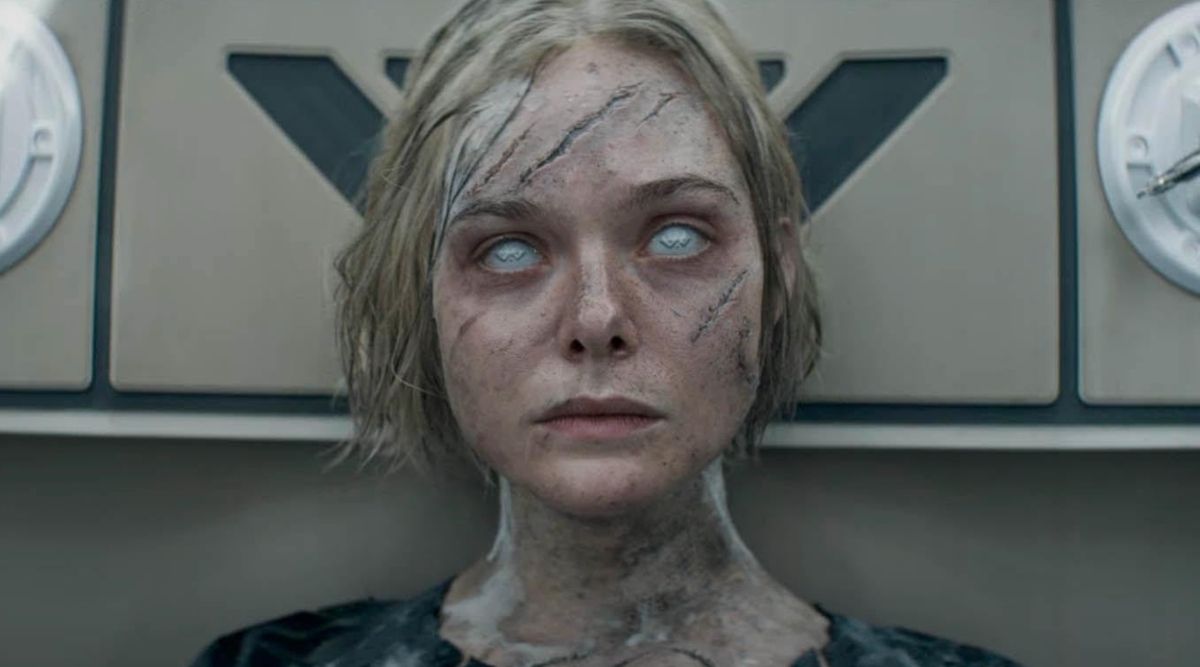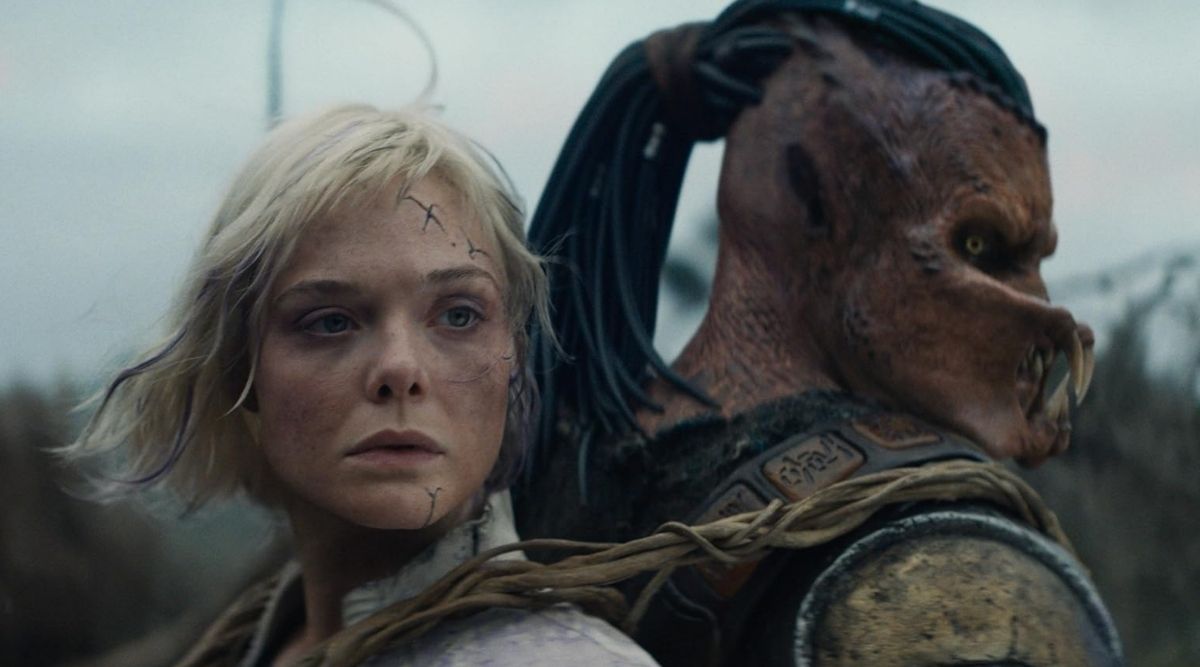Directed by Dan Trachtenberg and written by Patrick Aison, Predator Badlands continues Trachtenberg’s streak of new additions to the Predator film series. This time, and for the first time, the movie centers on a young Yautja predator, Dek (Dimitrius Schuster-Koloamatangi), as he prepares to pass the final trials of his clan and earn the invisibility cloak that marks a made Yautja.
To gain recognition from his clan, of which his father is the chief, Dek must successfully complete a hunt. These are the hunts made famous by the original Predator movies, where Yautja for generations have traveled through space to battle and slay the greatest predators of other planets. Dek, being the runt of his clan, has to work all the harder to earn his father’s respect and his place in the clan. He chooses the planet Genna, where its alpha species, the Kalisk, has never been slain before.
Immediately upon crash landing on Genna, Dek finds himself overwhelmed and outmatched by the planet full of killer creatures. It must have the densest population of dangerous flora and fauna in film. It’s unfortunate that poor CGI so squanders the beautiful, terrifying biomes of Predator Badlands.
A solid setup is squandered by frustrating CGI.

The vast majority of Predator Badlands appears to have been filmed on soundstages with digital backgrounds and mostly digital characters. It shows instantly when Dek fights his brother, Keri (Michael Homick), in the opening sequence, and the camera has to constantly cut away to compensate for the lack of a real-world environment from which to capture footage.
It gets worse as Dek crashes on Genna, and there is no depth to the planet whatsoever. All shots are focused on Dek, and whatever may exist in the background, even living, moving creatures, are blurred beyond sensibility. It’s hard to feel invested in an environment you’re only able to look at from afar, as the same “big predator is eaten by bigger predator” gag is reused multiple times in wide shots.
Alas, in the few moments where the movie is shot in real environments, namely when a waterfall is involved or there isn’t a forest of razor grass to depict, the movie does look pretty. Even Dek, in those moments, feels like a fully articulated, real character, like the Yautja were originally before CGI existed to cheapen effects and costumes.
The dialogue in Predator Badlands is some of the worst, most condescending dialogue in a studio film.

These brief moments of reality do some heavy lifting and help Dek feel more lived-in as the movie’s biggest sin comes into play: Thia (Elle Fanning). Shortly after crashing on Genna, Dek encounters Thia, the top half of a synth and the survivor of a Kalisk attack on her research team. While Fanning’s choice to play her as cloyingly sweet and naïve is admirable, she is also saddled with some of the absolute worst dialogue a big-budget studio film has ever employed.
Thia is written, above all, to serve as an audience surrogate character. She is constantly explaining things that Dek should know, blatantly telling the audience she’s going to speak English for their benefit, despite it being completely unnecessary and third-wall-breaking. She also repeats information that happened just moments ago ad nauseam. It’s all said in the most unintentionally patronizing tone of voice imaginable.
The entirety of Thia’s dialogue feels as if it were written because studio executives were afraid that people would be too busy multitasking while watching Predator Badlands on their phones to follow the plot. It’s offensively condescending to the audience and unbearable to listen to. Thankfully, Fanning puts her all into the role, and the character serves other purposes in the plot and in Dek’s journey. But this dialogue is truly some of the worst conceivable.
The action in Predator Badlands is exciting, even if the editing cheapens it.

If you ignore everything Thia ever says, Predator Badlands is fun, at least. Despite the shortcomings of the CGI world, the movie is nonstop action scene after action scene. None of the action moments feel repetitive or even really like one another at all. In fact, they feel unlike any scenes from any Predator movie thanks to the radically different environment and toolset that Dek is equipped with. It’s also different because the perspective is completely different.
There is some risk in turning the attention onto the Yautja. Over-explaining their customs or delving too deeply into their lore would feel cheap and perhaps diminish the allure of the entire brand in the process. Thankfully, Predator Badlands only offers just as much worldbuilding and exposition as necessary to apply stakes. It doesn’t go too overboard with the lore.
It comes close when introducing the true nature of Thia’s presence on Genna. The movie starts to wade a bit too far into franchise-building territory, almost losing track of the themes that make it—and its franchise—interesting: honor, machismo, and the futility of war, among them. However, the movie thankfully teeters on the right side of the edge and doesn’t completely give in to the extended-universe tendencies.
The themes in Predator Badlands are fascinating, albeit not fully explored.

Nonetheless, Predator Badlands feels like an overly simple morality tale on one end and a missed opportunity on the other. All of the development Dek has around those core themes feels simplistic, often because Thia spells them out so loudly. Were there no Thia at all, or perhaps just better dialogue, Dek’s character development would have felt better earned.
On the other hand, much of the attention given to Thia’s side plot takes away from the focus on Dek’s journey in exchange for a completely different set of moral quandaries: what is our purpose for being, who decides it, and who has the right to be the alpha species?
All of the questions are equally, if not more, interesting than the ones Dek’s quest to kill the Kalisk engenders. The movie’s many themes do culminate in the end, landing fairly well and less aggravatingly since Thia isn’t spelling them out quite as loudly. But Predator Badlands would have been all the better a movie if it had picked one lane or the other to explore instead of trying to straddle both.
It’s not that they’re incongruous, and hopefully future installments will continue to build on the interesting themes raised. But there isn’t enough time to give everything a fair amount of attention to feel fully realized, in between all of the bad dialogue weighing the pace down.
There’s a great movie trapped inside the middling Predator Badlands. Were Thia written differently, or not at all, the fascinating themes the movie broaches could perhaps have been explored more interestingly. And if the movie had been more invested in practical effects and sets, its action scenes might have been even stronger. Nonetheless, Predator Badlands is an okay movie—a fun time if you tune out its dialogue.
Predator: Badlands is in theaters everywhere November 7.
Predator: Badlands
-
Rating - 5.5/105.5/10
TL;DR
Dan Trachtenberg returns to the Predator series with Predator Badlands, an okay version of a strong concept weighed down by condescending dialogue.








